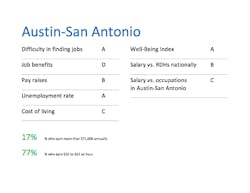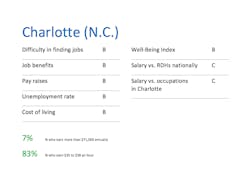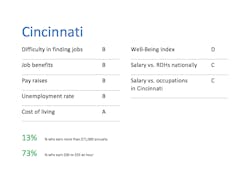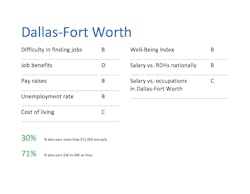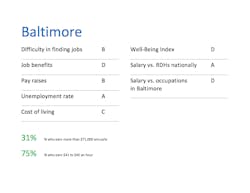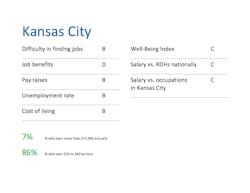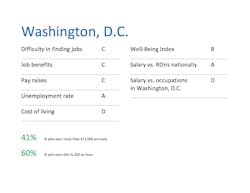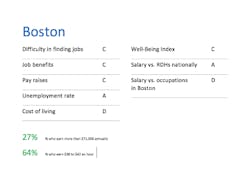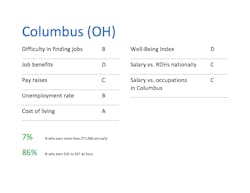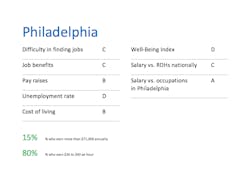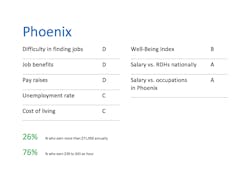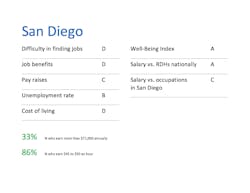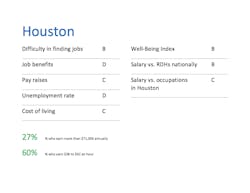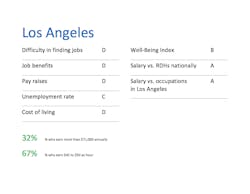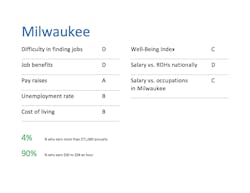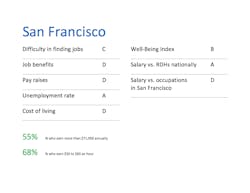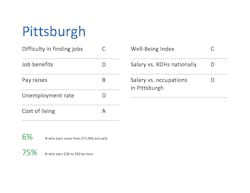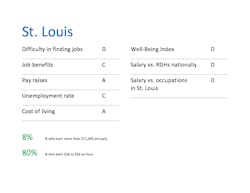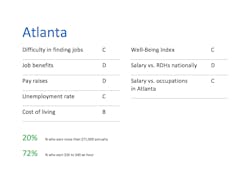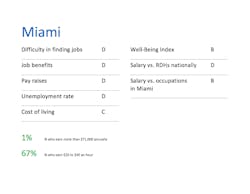Ranking 28 urban areas where dental hygienists live and work
In a primarily economy-based evaluation of 28 U.S. metropolitan areas, Denver and Austin-San Antonio emerged as the best places to practice dental hygiene.
The Denver metropolitan area enjoys one of the nation’s best economic environments, and dental hygiene salaries in the area position dental hygienists to enjoy economic clout—74% of Denver hygienists earn $38 to $42 an hour, which is a range slightly above the national average of $35 to $40.
Working in an occupation noted for tough job markets, only 27% of Denver hygienists say it is “difficult” to find jobs. In addition, the overall unemployment rate in the Denver area is the best among the 28 cities evaluated (2.9 as of November 2016).
The job market for dental hygienists in Denver, though, has some weaknesses, as its report card below suggests. While not as high as some west coast cities or New York City, cost of living expenses in Denver are above the national average. In addition, job benefits reported by Denver hygienists were mediocre.
Perhaps more importantly, the median household income of Denver, $69,908, was not that much lower than the reported annual income of dental hygienists in Colorado’s state capital.
Some of the concerns about living and working as a dental hygienist in Denver were echoed in the 2016 salary survey conducted by RDH eVillage.
For example, Denver is home to two of the state’s four dental hygiene schools. One hygienist noted, “The Denver area has too many hygienists. I worked as a temp for almost two years before landing a permanent job.”
Another hygienist warned against the boom of corporate dental offices in the city. “Corporate dentistry is huge in Denver. Many jobs are available but many are being filled by temps since the corporations offer lower pay, even with benefits.”
One veteran hygienist indicated on the salary survey that she earns $43 an hour and has nine weeks of paid vacation. “I feel lucky in that I love my job, bosses, and team members. I have no complaints with my career, but I am worried about all the other things I've heard going on out there.”
The statistics, however, point to Denver as a good place for dental hygienists to have a career. One hygienist reported, “There are a lot of jobs available in the area—a good mix of part time and full time. Most offices with full-time job offerings are providing health/vision insurance, uniforms, ability to earn paid time off, and paid vacations. A fair number do profit sharing, bonus potential on top of hourly/salary, and free dental.“
The report cards for the 28 metropolitan areas appear below. But here’s an explanation of how we derived this ranking for home bases of dental hygienists.
Ranked factors
RDH eVillage salary survey—The 2016 survey supplied information about the salaries, job benefits, pay increases, and the difficulties experienced in finding jobs. Overall, 2,544 U.S. dental hygienists participated in the survey; 37% of American dental hygienists work in one of these 28 cities.
Pay raises—The frequency of pay raises does not indicate the number of “cheapskate” employers in a city. It indicates how well dental practices treat employees when the percentage of collections permit pay increases.
Job benefits—The RDH eVillage survey asked dental hygienists about a smorgasbord of potential job benefits that are available to dental hygiene employees (but not necessarily enrolled in). The article’s evaluation considered the availability of health insurance, retirement plan, and paid vacation among full-time dental hygiene employees.
Federal statistics—The Bureau of Labor Statistics provides a wealth of information on income levels for all occupations, including dental hygiene. The BLS also provides cost-of-living indexes and other economic reviews about a metropolitan area.
The average annual income estimates come from the federal government. Based on the RDH eVillage survey, PennWell disagrees with the federal estimates. For example, in some cities, the average hourly rate posted by dental hygienists in the RDH eVillage survey would mean that dental hygienists would have to work in excess of a 40-hour workweek all year long to earn what the government says they’re earning. It’s not impossible; hygienists are hard workers. But it’s also unlikely, given the current business practices of dental employers.
Well-Being Index—Gallup derives its Well-Being Index for 190 urban and smaller cities across the United States. Gallup bases its analytics for the index on consumer “insecurity” about the various factors influencing where residents live. The parts of the Well-Being Index reflected in this evaluation pertain to residents’ self-motivation to achieve goals, pride in the community, and good health. When considering the grades, remember that the urban sprawls were very much challenged in the Gallup rankings by smaller cities.
Unranked factors
The report cards refer to a range of hourly rates earned by dental hygienists in a city. This range of wages did not directly influence the rankings. Obviously, though, the higher the range the more likely dental hygienists would earn a higher annual income, as well as potentially fare well against the incomes of other occupations in their cities (but not exclusively so; see the report for Washington, D.C.).
As mentioned above, the BLS statistics for annual incomes were used for this evaluation. The federal government also estimates that the average American dental hygienist earns $72,720 a year. So we included the percentage of dental hygienists in a city who earn more than what the government says they are earning, but the percentage was not a part of the ranking.
Top Floor/Corner Offices—Denver, Austin-San Antonio
Comments: The distance between Austin and San Antonio is 74 miles. The land between the two cities has filled in with bedroom communities for both cities. Some Austin hygienists may think San Antonio knocks them down to second place. After all, salaries are higher in Austin. But not so fast. San Antonio’s statistics are very comparable, and the cost-of-living index is almost eight percentage points lower in the Alamo City.
Sixth Floor/Vice President Suites—Charlotte (N.C.), and Minneapolis
Comments:Charlotte received a respectable “B” in most categories, and did not flunk anything. Keep an eye on the unemployment rate, though. After spending 2015 well above the national average, the rate climbed down to just a percentage point below the national average in 2016. As was the case with Denver, the overall job outlook in Minneapolis is very good. Forty-seven percent of Minneapolis dental hygienists said they got a raise last year. On the down side, the weight of dental hygiene salaries is fairly weak against other occupations, and dental hygiene jobs can be hard to find.
Fifth Floor/Project-Marketing Managers—Cincinnati, Dallas-Fort Worth
Comments:Cincinnati is on the cheaper side for living expenses. The city fares better than its Ohio counterparts evaluated in this article. It’s more difficult to find a job in Cleveland (88% to 40% for Cincinnati). The main drawback is the aforementioned Well-Being Index, which is something all three Ohio cities struggled with in the rankings. The DFW metropolitan area struggled in one category. Only 41% reported the availability of health insurance, and only 48% have a retirement plan based at least partially on the employer. Other than that glaring oversight, Dallas-Fort Worth hygienists enjoy the benefits of a solid economy. But its 8.4% above-average status in costs of living is the highest of the top six cities.
Fourth Floor/Accounting Department—Baltimore, Chicago, Kansas City, Seattle, and Washington, D.C.
Comments:Baltimore’s scores were notable due to the federal government’s projection that the average Baltimore dental hygiene salary of $83,470 is excellent in a landscape already filled with San Francisco, Los Angeles, and New York City. Chicago dental hygienists generally report good income and benefits when a job is landed (54% said it’s hard to find a good job). Kansas City fared well in job availability and pay raises, as well as with other economic criteria. Overall salary conditions were mediocre, though. “Salaries and benefits are down and have been since 2009,” and “Way too many RDH schools, which lets dentists treat RDHs as they wish,” were a couple of the comments from Kansas City hygienists. Like Boston, which is on the third floor below, Seattle can be a terribly expensive place for a dental hygienist to live. Unlike Boston, Seattle offers better income and benefits, and jobs can be found. Maybe the incoming administration at the White House will change things. At the moment, hygienists in Washington, D.C., are the only group among these 28 metropolitan areas who earn less than the median household income for the area.
Third Floor/Clerical Staff—Boston, Columbus (OH), Philadelphia, Phoenix, and San Diego
Comments: On the top end of the Northeast megalopolis is Boston. The city has seen a tremendous boost during the rapidly falling unemployment numbers. Boston, however, remains one of the most expensive cities for dental hygienists to reside in. Only 13% of Columbus’ full-time hygienists said health insurance was available. Detroit was the only city to report a better consumer price index than Columbus. Philadelphia dental hygienists barely earn the national average for dental hygienists, but their income stacks up well against other occupations in the city. Philadelphia is also grouped into the “Northeast megalopolis,” but the cost-of-living expenses really aren’t that bad. Only 10% of Phoenix hygienists reported a raise within a one-year period, and benefits are not in a much better situation. One Phoenix hygienist commented, “Our market is supersaturated, and the hourly wage has decreased. Employers prefer to hire part time so as to avoid benefits.” San Diego received the best Gallup Well-Being Index score in comparison with the other California cities discussed here, but was the worst among the three Golden State metropolitan areas in terms of difficulty in finding work.
Second Floor/Assistant Sales Managers—Houston, Los Angeles, Milwaukee, New York City, Orlando-Tampa, San Francisco
Comments: Cheap gas is loved by everyone but Houstonians, where energy woes have impacted the local economy for many months. When it becomes more costly to fill our tanks, Houston is in a good position to rise upward in future rankings. But, like Dallas and Fort Worth above, hygienists in Houston would feel better if benefits packages were improved a bit. We referred to San Diego’s status among California cities up on the third floor above. Like most of the West Coast cities analyzed, Los Angeles pays good salaries. In addition, those Los Angeles salaries have more influence when compared to median home incomes in Los Angeles. Milwaukee hygienists get raises; 43% reported receiving one within the last year. If only the pay increases could be converted into job benefits. Milwaukee was weak in the regard of giving full-time hygienists an option in health insurance or a retirement plan. We’d love to be able to simply ask, “Have you purchased anything recently in New York City?” Actually, the Big Apple is only the fourth worst cost-of-living index among the 28 cities evaluated here. The salaries of New York hygienists compare favorably with the salaries of other occupations in the metropolitan area. You can make the same claim about hygienists in the Orlando-Tampa area. Hygiene salaries can pay the bills. Unfortunately pay raises and job benefits gravitate toward the bottom in Orlando-Tampa and Miami. If you’re looking for the latter’s report card, take the elevator down to the basement. San Francisco, as noted on the report card, has the nation’s highest range of hourly rates. Hygienists need every single cent of those wages for paying the bills, though. But jobs are available as the Bay Area enjoys one of the country’s lowest unemployment rates.
Ground Floor/Reception Area—Pittsburgh, St. Louis
Comments: We believe visitors should derive a good first impression upon entering the building. Hygienists in Pittsburgh and St. Louis do enjoy a good cost-of-living status and routinely enjoy pay raises.
Basement/Fluorescent lights flicker around the clock—Atlanta, Cleveland, Detroit, Miami
Comments: Is anyone down here? Awful dark and hard to see. Atlanta is supposed to be the jewel of the South. Why are they treating dental hygienists so badly there? Miami rarely has cold temperatures. Is there a penalty for hygienists who want to enjoy warm weather? Cleveland and Detroit are often bullied in these types of rankings. But it is comparatively cheap to live in these two Rust Belt cities.
For the most current dental headlines, click here.
About the Author

Mark Hartley
Mark Hartley is the editor of RDH magazine and collaborates with Kristine Hodsdon on many of the articles for RDH eVillage, which also appear on DentistryIQ.com.


